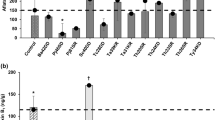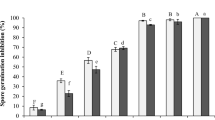Abstract
Aflatoxins are carcinogenic, teratogenic and immunosuppressive secondary metabolites produced by Aspergillus flavus and Aspergillus parasiticus. Aflatoxin contamination of peanut is one of the most important constraints to peanut production worldwide. In order to develop an eco-friendly method of prevention of A. flavus infection and aflatoxin contamination in peanut, aqueous extracts obtained from leaves of 30 medicinal plants belonging to different families were evaluated for their ability to inhibit the growth of A. flavus in vitro. Among them the leaf extract of zimmu (Allium sativum L. × Allium cepa L.) was the only one that showed antifungal activity against A. flavus and recorded 73% inhibition of A. flavus growth. The antifungal activity of the zimmu extract was significantly decreased upon dialysis with a dialysis membrane having molecular cut off 12 kDa or autoclaving at 121°C for 20 min or boiling at 100°C for 10 min and recorded inhibition of 52, 16 and 21%, respectively. When A. flavus was grown in medium containing zimmu extract the production of aflatoxin B1 (AFB1) was completely inhibited even at a concentration of 0.5%. When AFB1 was incubated with zimmu extract a complete degradation of AFB1 was observed 5 days after incubation. When the roots of zimmu were incubated in water containing 70 ng of AFB1/ml, a reduction (by 58.5%) in AFB1 concentration was observed 5 days after incubation. A significant reduction in the population of A. flavus in the soil, kernel infection by A. flavus and aflatoxin contamination in kernels was observed when peanut was intercropped with zimmu. The population of the fungal antagonist, Trichoderma viride in the zimmu-intercropped field increased approximately twofold.



Similar content being viewed by others
References
Adhikari TB, Bansyat RC (1998) Effect of crop rotation and cultivar resistance on bacterial wilt of tomato in Nepal. Can J Plant Pathol 20:283–287
Asis R, Barrionuevo DL, Giorda LM, Nores ML, Aldao MA (2005) Aflatoxin production in six peanut (Arachis hypogaea L.) genotypes infected with Aspergillus flavus and Aspergillus parasiticus, isolated from peanut production areas of Cordoba, Argentina. J Agric Food Chem 53:9274–9280
Awuah RT (1989) Fungitoxic effects of extracts from some West African plants. Ann Appl Biol 115:451–452
Bankole SA (1997) Effect of essential oils from two Nigerian medicinal plants (Azadirachta indica and Morinda lucida) on growth and Aflatoxin B1 production in maize grain by atoxigenic Aspergillus flavus. Lett Appl Microbiol 24:190–192
Bankole SA, Adebanjo A (1995) Inhibition of growth of some plant pathogenic fungi using some Nigerian medicinal plants. Int J Trop Plant Dis 13:91–95
Beekrum S, Govinden R, Padayachee E, Odhav B (2003) Naturally occurring phenols: a detoxification strategy for fumonisin B1. Food Addit Contam 20:490–493
Bell DK, Doupnik B (1970) Efficacy of chemicals for control of aflatoxin in peanut pods. J Am Peanut Res Educ Assoc 2:35–38
Bennett JW, Christensen SB (1983) New perspective of aflatoxin biosynthesis. Adv Appl Microbiol 29:53–92
Brenneman B, Wilson DM, Beaver RW (1993) Effects of Diniconazole on Aspergillus populaton and Aflatoxin production in peanut under irrigated and non irrigated conditions. Plant Dis 77:608–612
Elad Y, Chet If (1983) Improved selective media for isolation of Trichoderma or Fusarium spp. Phytoparasitica 11:55–58
Fiori ACG, Schwan-Estrada KRF, Stangarlin JR, Vida JB, Scapim CA, Cruz MES, Pascholati SF (2000) Antifungal activity of leaf extracts and essential oils of some medicinal plants against Didymella bryoniae. J Phytopathol 148:483–487
Ghewande MP, Nagaraj G, Desai S, Narayan P (1993) Screening of groundnut bold–seeded genotypes for resistance to Aspergillus flavus seed colonization and less aflatoxin production. Seed Sci Technol 21:45–52
Griffin GJ (1970) Conidial germination and populaton of Aspergillus flavus in the geocarposphere of peanut. Phytopathology 60:1387–1391
Huang RH, Xiang Y, Liu XZ, Zhang Y, Hu Z, Wang DC (2002) The novel antifungal peptides distinct with a five-disulfide motif from the bark of Eucommia ulmoides Oliv. FEBS Lett 521:87–90
Joffee AZ, Lisker KD (1970) Effect of crop sequence and soil types on the mycoflora. Plant Soil 3:393–406
Keshri S, Basu M (2003) Evaluation of aflatoxin contamination in different species. Indian Phytopathol 56:457–459
Lam SK, Ng TB (2002) Pananotin, a potent antifungal protein from roots of the traditional Chinese medicinal herb Panax notoginseng. Planta Med 68:1024–1028
Mellon JE, Cotty PJ, Godshall MA, Roberts E (1995) Demonstration of aflatoxin inhibitory activity in a cotton seed coat xylan. Appl Environ Microbiol 61:4409–4412
Michel VV, Hartman GL, Midmore DJ (1996) Effects of previous crop on soil populations of Burkholderia solanacearum, bacterial wilt, and yield of tomatoes in Taiwan. Plant Dis 80:1367–1372
Moreno OJ, Kang MS (1999) Aflatoxin in maize: the problem and genetic solutions. Plant Breed 118:1–16
Nahdi S (1996) Drought stress and preharvest seed invasion of selected groundnut genotypes by Aspergillus flavus and aflatoxin contamination. Indian Phytopathol 49:52–56
Ong T (1975) Aspergillus flavus mutagenesis. Mutat Res 32:35–53
Pettit E, Taber RA, Schroeder HW, Harrison AL (1971) Influence of fungicides and irrigation practice on aflatoxin in peanuts before digging. J Appl Microbiol 22:629–634
Polan CE, Hayes JR, Campbell TC (1974) Consumption and fate of aflatoxin B1 by lactating Cows. J Agric Food Chem 22:635–638
Satya VK, Radhajeyalakshmi R, Kavitha K, Paranidharan V, Bhaskaran R, Velazhahan R (2005) In vitro antimicrobial activity of zimmu (Allium sativum L. x Allium cepa L.) leaf extract. Arch Phytopathol Plant Prot 38:185–192
Thakur RP, Rao VP, Subramanyam K (2003) Influence of biocontrol agents on population density of Aspergillus flavus and kernel infection in groundnut. Indian Phytopathol 56:408–412
Waliyar F, Ba A, Hassan H, Bonkoungou S, Bosc JP (1994) Sources of resistance to Aspergillus flavus and aflatoxin contamination in groundnut genotypes in West Africa. Plant Dis 78:704–708
Wilson DM, Stansell JR (1983) Effect of irrigation on aflatoxin contamination of peanuts pods. Peanut Sci 10:54–56
Yamunarani K, Jaganathan R, Bhaskaran R, Govindaraju P, Velazhahan R (2005) In vitro antifungal activity of a 29-kDa glycoprotein purified from the galls of Ouercus infectoria. Acta Phytopathol Entomol Hung 40:43–54
Yu X, Trapp S, Zhou P (2005) Phytotoxicity of cyanide to weeping willow trees. Environ Sci Pollut Res 12:109–113
Acknowledgement
This research was supported by the Indian Council of Agricultural Research, New Delhi, India.
Author information
Authors and Affiliations
Corresponding author
Rights and permissions
About this article
Cite this article
Sandosskumar, R., Karthikeyan, M., Mathiyazhagan, S. et al. Inhibition of Aspergillus flavus growth and detoxification of aflatoxin B1 by the medicinal plant zimmu (Allium sativum L. × Allium cepa L.). World J Microbiol Biotechnol 23, 1007–1014 (2007). https://doi.org/10.1007/s11274-006-9327-x
Received:
Accepted:
Published:
Issue Date:
DOI: https://doi.org/10.1007/s11274-006-9327-x




